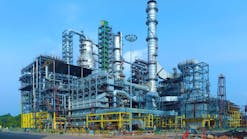USING SAND to prop open fractures when completing wells isn't new to the oil and gas industry, but the exponential growth in the amount of sand used in completions is. In an April research note, Douglas Westwood detailed concerns about "a shortage of frac sand for the US shale plays, specifically 40/70 frac sand in the Permian Basin."
More recently, as part of the interview conducted with Fairmount Santrol for this issue, CEO Jenniffer Deckard detailed demand specific to the Permian Basin.
"You can expect to see new mines come online from the industry this year and next, primarily in the Permian Basin," she said, noting that the company expects proppant demand "to expand both within the Permian Basin and in regions outside of the Permian Basin, so additional supply will be needed." She said she doesn't expect all operators "to do a complete conversion to regional sand grades and quality," thus "leaving some of the Permian Basin demand to be addressed from current supply," but went on to note that Fairmount has started construction on its Kermit mine in the Permian "to meet the growing demand for in-basin, regionally produced sand," as well as the demand for smaller mesh sizes. You can read more from the interview on page 18 of this issue.
Going back to the Douglas Westwood report, advancements in horizontal drilling and completion techniques, as well as high-intensity completions, and the significance of multi-well pad drilling in the Permian are driving frac sand demand. The firm, citing Q1 2017 data from Energent Group, said that "the majority of new Delaware Basin completions use, on average, 1,990 pounds of frac sand per lateral foot."
Another driver is the longer laterals per well in the shale plays, Douglas Westwood continued, noting that as E&Ps acquire more continuous acreage, we can expect the two-mile lateral to be much more common. For the last two years, on average, horizontal well lengths in the Midland Basin neared 7,500 lateral feet, the firm reported.
In a late September, in a note containing highlights from its Oil & Gas Leaders Conference, Wolfe Research commented on regional sand, specifically. "Over the last several years many frac sand companies have been purchasing or expanding regional sand capacity. Most large sand companies have or are pursuing regional sand mines. With rail costs comprising such a significant component of delivered costs and E&Ps preferring finer mesh sand, WR sees frac sand companies increasingly expanding, developing or purchasing regional sand mines."
This is certainly happening in the Permian.
In late July, Badger Mining Corp. purchased property containing sand reserves located north of Kermit, Texas. The property contains over 35 years of estimated sand reserves, predominately featuring finer grades of sand such as 40/70 and 100 mesh. The reserve will add in-basin Texas sand to the company's portfolio.
Development of the site for a sand mining facility will begin immediately with an anticipated completion date of April 2018. Once complete, the mine will have a capacity of 3 million tons per year.
In early August, Black Mountain Sand LLC, an NGP-backed sand supplier primarily serving the Permian Basin, announced a multi-year supply contract with Diamondback Energy Inc. set to begin in early 2018. This agreement ensures Diamondback's continuity of frac sand supply through committed capacity of Black Mountain's two 4 million tons per year facilities and 1.5 billion tons of in-basin frac sand reserves. Black Mountain will dedicate a substantial portion of its Permian mine capacity to Diamondback, providing in-basin 100 mesh and 40/70 frac sand.
In June, US Silica Holdings Inc. (SLCA) announced plans to build a new frac sand mine and 4 million ton per year plant in the Permian for $225 million. The 3,200-acre site has over 30 years of 40/70 (30%) and 100-mesh (70%) reserves. Initial production is scheduled for late 4Q17. In its analysis of the news, Cowen and Company said the $225 million purchase price "includes land and construction costs and is attractive implying $56/ton versus the most recent Permian sand deal at $108/ton. Assuming $140 million of EBITDA (assuming a delivered marginal cost per ton to West Texas of $75, production cost of $15/ton, last mile cost of $25/ton, and a $75/ton well head price) implies a 1.6x multiple compared to SLCA trading at 5.8x our 2018 estimate." Of note the analyst continued, "the property is not part of the dunes everyone has been reviewing on Google maps," but "a subsurface resource on a ranch near Monahans State Park."
An important side note: certain areas in the region are inhabited by the dunes sagebrush lizard. A conservation plan for the lizard was implemented in 2012 by the State of Texas. More recently, the Texas Comptroller of Public Accounts informally mentioned the habitat to the US Fish & Wildlife Services agency, noting the Permian frac sand permitting rush.
Back to frac sand: In late September, SLCA announced a $150 million plan to build a second frac sand mine and plant in West Texas. The new facility, located about 60 miles north of Midland, is expected to produce approximately 2.6 million tons annually. The company has secured customer commitments for the purchase of 1.2 million tons per-year of sand including cash pre-payments, and for up to four Sandbox crews to deliver the sand from the mine to customer well sites. Initial production is expected in March of 2018. The 3,500-acre site has over 30 years of reserves of fine grade 40/70 and 100 mesh.
I've been told that frac sand use in 2017 is on pace to greatly exceed its peak set in 2014. Regional sand stands out as one way for companies to mitigate delivery costs. Still, as experts from a frac sand panel at the aforementioned Wolfe Research Oil & Gas Leaders Conference agree, "potential truck congestion, financial backing, operational history, and customer contract appetite remain as constraints." And, perhaps, the dunes sagebrush lizard.

Mikaila Adams | Managing Editor - News
Mikaila Adams has 20 years of experience as an editor, most of which has been centered on the oil and gas industry. She enjoyed 12 years focused on the business/finance side of the industry as an editor for Oil & Gas Journal's sister publication, Oil & Gas Financial Journal (OGFJ). After OGFJ ceased publication in 2017, she joined Oil & Gas Journal and was named Managing Editor - News in 2019. She holds a degree from Texas Tech University.

